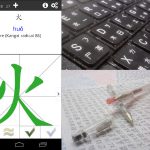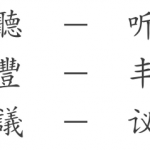Articles tagged with ‘Characters’ Page 2
-
7 ways of learning to write Chinese characters
There are many ways of practising writing Chinese characters and they all have their pros and cons. In this article, I discuss seven different ways of practising and what advantages and disadvantages they have for you as a learner. Which do you use?
Read → -
Sensible Chinese character learning challenge 2014
The 2014 sensible Chinese character learning challenge starts soon! This article introduces the challenge and how you join us. Apart from learning a lot of characters and improving the way you learn characters, you also get a discount and free extensions on Skritter, as well as a chance of winning character posters from Hanzi WallChart!
Read → -
Sensible Chinese character learning revisited
In a way, learning Chinese characters is very much like learning vocabulary in any foreign language and much of the efficient methods developed there works well for Chinese as well. However, characters are also fundamentally different from words in English and this influences how we should learn them as well. This article is a recap of how to learn Chinese characters in a sensible way. It is also a prologue for the upcoming character learning challenge.
Read → -
Horizontal vocabulary learning in Chinese
The normal thing to do when we learning characters or words is to focus on deepening our knowledge, researching components and understanding more about what we’re trying to learn. Some problems can’t be alleviated this way, however, instead they call for horizontal vocabulary learning, i.e. to putting the character or word into context and to compare it with similar characters or words. Only then can we grasp the bigger picture.
Read → -
Don’t use mnemonics for everything
Mnemonics are really cool, but you shouldn’t overuse them. Chinese characters are very complex and the amount of information you might want to remember about them is large. Creating mnemonics for everything is very time consuming and difficult. Instead of doing this, create mnemonics only for things you actually find hard to remember.
Read → -
How to create mnemonics for general or abstract character components
Anyone who has tried mnemonics for learning Chinese characters knows that some components are easier to link together than others. This article discusses in detail how to deal with abstract or general character components and how to handle components with the same or overlapping meaning, an essential skill if you’re serious about character learning.
Read → -
Sensible character learning: Progress, reminders and reflections
The sensible character challenge has now been running for two weeks and it’s time to see how things have been going so far. This post is a progress report that contains some reflections on the challenge itself, as well as some practical advice on how to solve common problems. It also invites participants to share their experience and progress so far.
Read → -
Towards a more sensible way of learning to write Chinese
This character learning challenge strives to teach students to learn Chinese characters in a way that makes sense in the long term. While the challenge is over, the principles are still applicable!
Read → -
You can’t learn Chinese characters by rote
My conclusion after years of learning characters is that rote learning is useless. Spaced repetition software is good, but it’s still not enough. If adult foreigners are going to learn to write Chinese by hand, we really need another method. We need mnemonics, we need active processing, we need to quit rote learning and stop using SRS mechanically.
Read → -
Learning simplified and traditional Chinese
Learning traditional characters if you know simplified or vice versa is a lot easier than beginners tend to think. Generally, you don’t need to worry, because at an advanced level, learning both is quite easy. This article is about simplified/traditional and how to learn both.
Read →




